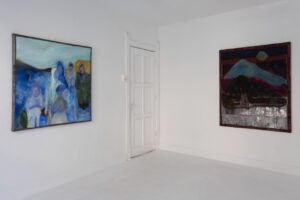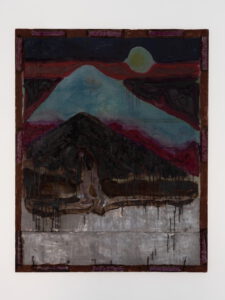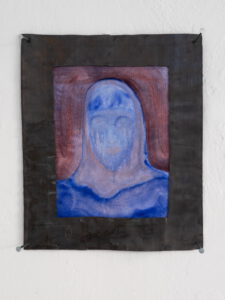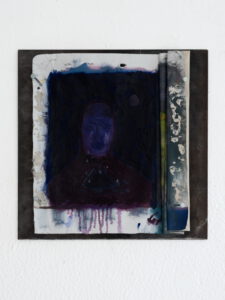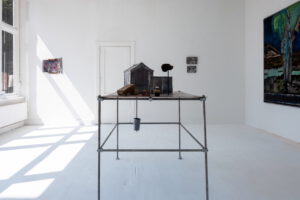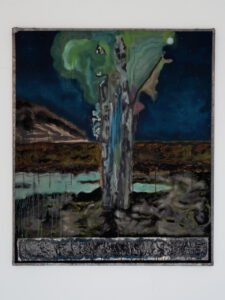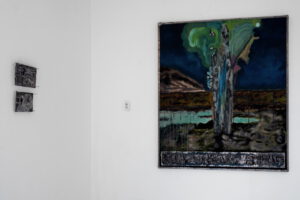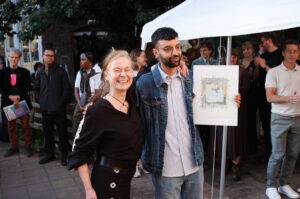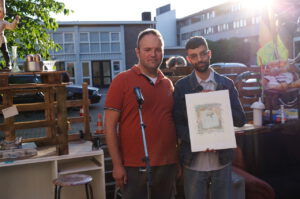Mounir Eddib
Jury Rapport
Juryleden
Aline Thomassen,
artist, https://alinethomassen.com
Barbara Strating,
curator, Maastricht University, https://www.maastrichtuniversity.nl/news/barbara-strating-appointed-um-curator
Ranti Tjan,
curator and head Collection and Exhibitions, Het Noordbrabants Museum https://www.hetnoordbrabantsmuseum.nl/het-museum/over-ons/wie-zijn-we/
Jury Rapport
Gilbert de Bontridder Award 2024:
Voiced by Aline Thomassen, also on behalf of Barbara Strating and Ranti Tjan
The arts is first and foremost a profession, for which the fourth-year Fine Arts students all obtained their qualifications this week in the form of a degree certificate. It is the skill of turning a concept, idea or intuition into an image, interpreting that image as broadly as possible.
Whether it is an almost inaudible sound, a layered sculpture of soft textiles, a series of memories of a dear family member, a church erected to celebrate your own identity or a traditional painting: you have all shown that you are able to create an image from an artistic vision.
The Gilbert de Bontridder Award 2024 is awarded to that artist among you who exhibits drive, work ethic and innovative ideas in addition to a compelling vision.
Moreover, this artist should have an interest in the connection between theory, fine art and art history and ideally refer to artists from that tradition in their work. This leads us to three artists who stand out, two of whom we would like to give an honourable mention.
The first honourable mention is for Alessio Faustini. Using found footage, Alessio manages to evoke mystery. On the one hand, the work is an archive of unknown people. He has put together a story based on images and the suggestions that come from those images, thereby allowing the viewer to reconstruct a possible life story. At the same time, Alessio has made a link with technology by having the story written by AI. The jury was very impressed by the two slides in the darkroom, where the after-image continues to shine so beautifully when the fluorescent paint is illuminated through the slide, that the poetry naturally imposes itself on the image. The graduation project demonstrates a vivid vision of artistic research and the power of images.
The second honourable mention is for Valentijn Schmitz. When entering Valentijn’s exhibition, you may think it is a completely safe, face powder-like world, but appearances are deceptive. An attendant draws visitors into the artwork by putting objects around their shoulders that are part of the exhibition. The work thus raises questions about the distinction between visitor and artwork, looking and being looked at. Underneath this is a layer of social criticism about the balance of power between cleaners and the users of the Zuyd University premises they clean. Valentijn makes their work visible through large areas of colour on the floor, an interview and posters. The installation demonstrates a heartfelt socio-critical view of the role of art in our society.
However, considering the criteria for the Gilbert de Bontridder Award, the jury can declare only one student the winner, and that is Mounir Eddib.
Mounir’s paintings are very eloquent. They testify to personal histories and stories, the history of mining in the Euregion, racism, migration, environmental pollution and injustice.
However, what gives the images their eloquence is that, from the personal, they manage to punch through to a universal layer. This is how they leave a lasting impression on us, like a Hindia, a prickly pear leaving its spines in your hand – invisible, yet impossible to remove.
Spirit-like apparitions of people, stripped of individual characteristics such as skin colour and even gender, loom over landscapes that seem to emerge from a secret, intuitive source, a contemporary source that both contains memories of the past and looks forward to the future.
What we see is a natural world, but one that seems charged by toxic materials and signifiers of tar and lead. Or does it actually repel this toxicity?
Mounir Eddib has taken two separate worlds and created a new one, with apparent effortlessness and with an impressive freedom of switching between the two. Deftly but lovingly, Mounir plays with the weight of Western painting and the magical world of your mother or your ancestors, where magic, destiny and warding off evil tangibly permeate everyday life, such as through scents and magically charged materials. These two worlds find common ground in his work, evoking the unspeakable. That common ground is the language of the image. The power of the image is that it seems capable of uniting apparent opposites, making us realise that we are one and that we share the same human experience. Together, we are humanity.
Mounir Eddib, congratulations on your victory!
Fotogalerij
